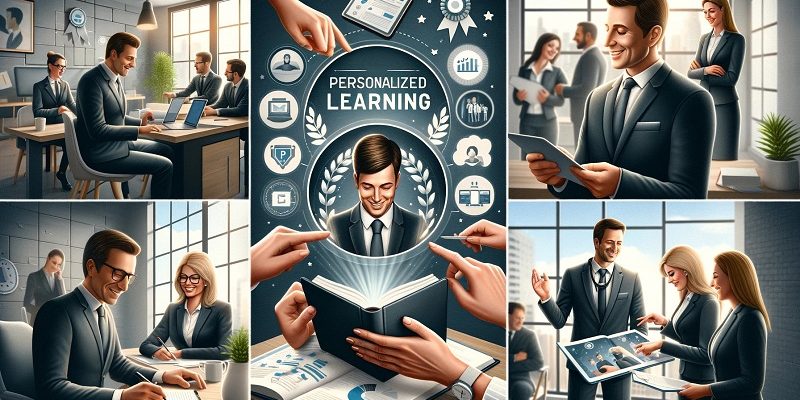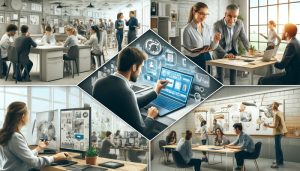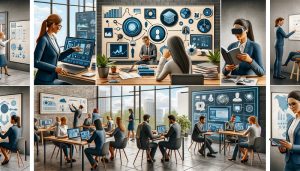The one-size-fits-all approach to employee learning and development is becoming obsolete. The burgeoning trend is personalized employee learning – an approach that recognizes and caters to the unique career paths, skills, and learning preferences of individual employees. This tailored approach not only enhances the effectiveness of training programs but also significantly boosts employee engagement and retention.
The evolution towards personalized learning
Traditional learning and development programs often fail to address the diverse needs and goals of a varied workforce. In contrast, personalized learning shifts the focus from a standardized curriculum to customized learning experiences. This method acknowledges that every employee has different career aspirations, varying levels of knowledge, and preferred learning styles.
Personalized employee learning involves designing training programs that are tailored to the individual learning needs, career goals, and preferences of each employee. It encompasses a range of strategies, from offering diverse course formats (online, in-person, microlearning, blended learning) to allowing employees to choose their learning paths and pace.
Benefits of personalized learning
Personalized learning offers a multitude of benefits for both employees and organizations. By tailoring learning experiences to individual needs and preferences, companies can foster a more engaged, skilled, and adaptable workforce. Here’s a closer look at some key advantages:
- Enhanced engagement and motivation: when employees see that their specific needs and goals are being addressed, they are more likely to be intrinsically motivated to learn. Personalized learning allows them to take ownership of their development journey, leading to increased engagement with the learning material and a higher chance of applying it in their roles.
- Improved learning outcomes: tailored learning experiences ensure that employees focus on areas where they need the most development, leading to more effective skill acquisition and knowledge retention. This targeted approach eliminates the frustration of irrelevant training and allows employees to bridge skill gaps more efficiently.
- Increased employee retention: investing in employees’ personal and professional growth demonstrates a commitment to their well-being and future success. This fosters a sense of loyalty and job satisfaction, which can significantly influence turnover and the associated costs of recruiting and onboarding new employees.
- Adaptability to organizational needs: personalized learning allows organizations to develop a more agile and adaptable workforce. By identifying and addressing individual skill gaps, companies can ensure they have the necessary competencies to meet evolving business goals and stay ahead of the curve in a dynamic marketplace.
- Reduced training costs: personalized learning can be more cost-effective than traditional one-size-fits-all training programs. By focusing on specific needs, companies can eliminate unnecessary training modules and optimize their learning and development budgets.
- Improved training ROI: when training is targeted and relevant, employees are more likely to see the value in their development opportunities. This translates into a higher return on investment (ROI) for the company, as the acquired skills are directly applicable to their work and contribute to organizational success.
Overall, personalized learning offers a compelling approach to employee development. By tailoring learning experiences to individual needs and goals, companies can cultivate a more engaged, skilled, and adaptable workforce, ultimately contributing to a competitive advantage in the marketplace.
Challenges in personalized learning
While personalized learning offers significant advantages, implementing it effectively requires careful consideration of several challenges:
- New investments: developing and delivering individualized learning content can be resource-intensive. Creating personalized learning paths, identifying appropriate learning materials, and providing ongoing support for individual learners requires a significant investment in time, personnel, and technology.
- Ensuring equity of access: it’s crucial to ensure that all employees, regardless of background, experience level, or location, have equal access to personalized learning opportunities. This may involve addressing potential barriers such as limited access to technology, learning disabilities, or language proficiency. Companies may need to invest in additional resources, such as translation services or assistive technologies, to bridge these gaps.
- Aligning individual goals with organizational needs: striking a balance between individual learning goals and organizational needs can be challenging. While personalized learning should cater to individual development, it’s also important to ensure that employees are acquiring skills that are relevant and contribute to the organization’s overall objectives. Regular communication, goal setting discussions, and mentorship programs can help ensure alignment between personal and organizational goals.
- Managerial capabilities: the success of personalized learning hinges on the active involvement and support of managers. Managers need to be equipped with the skills to assess individual needs, set clear learning goals, provide ongoing feedback, and coach their employees throughout the learning process. Investing in training programs for managers on effective coaching and development techniques can be crucial.
- Scalability and sustainability: scaling personalized learning initiatives to accommodate a large workforce can be challenging. Finding efficient and cost-effective ways to deliver personalized learning experiences across different departments, roles, and locations requires careful planning and technological solutions.
- Data privacy concerns: personalized learning often involves collecting and analysing individual learning data. Companies need to ensure that data privacy is respected and that employee learning data is handled responsibly and securely, in accordance with relevant regulations.
Potential solutions:
- Leveraging technology: learning management systems (LMS) with personalization features can automate tasks such as content curation, progress tracking, and recommendation engines, making personalized learning more scalable.
- Microlearning and adaptive learning: breaking down learning content into bite-sized modules and using adaptive learning technologies that adjust based on individual performance can improve accessibility and cater to different learning styles.
- Content curation and collaboration: curating existing learning resources, leveraging open-source materials, and encouraging knowledge sharing among employees can help address content development challenges.
- Blended learning approach: combining personalized online learning modules with in-person coaching, workshops, and mentorship opportunities can create a well-rounded learning experience.
By acknowledging these challenges and exploring potential solutions, organizations can overcome the obstacles to implementing personalized learning and reap the significant benefits it offers for both employees and the organization as a whole.
Implementing personalized learning programs
The implementation of personalized learning requires a strategic approach:
- Assessment of individual learning needs: understanding each employee’s current skill level, career aspirations, and learning preferences is the first step. This can be achieved through assessments, surveys, and one-on-one discussions to identify strengths, weaknesses, and development goals.
- Flexible and diverse learning materials: offering a variety of learning materials and formats caters to different learning styles. This could include: online courses with interactive elements like quizzes and simulations, microlearning modules that deliver bite-sized chunks of information, video tutorials and explainer videos for visual learners, case studies and real-world scenarios for applying knowledge to practical situations, hands-on projects and experiential learning opportunities, podcasts, audiobooks, and other audio resources for auditory learners, access to industry publications, professional journals, and online learning communities.
- Technology integration: leveraging Learning Management Systems (LMS) and other educational technologies can facilitate personalized learning paths, track progress, and provide valuable analytics. Consider utilizing other technological tools like collaboration platforms for knowledge sharing and peer-to-peer learning, virtual reality simulations for immersive training experiences, and mobile learning apps for on-the-go access to learning materials.
- Continuous feedback and adjustment: actively solicit feedback from employees throughout the learning process. This can be done through surveys, focus groups, or informal check-ins with managers. Use the gathered feedback to continuously refine and improve your personalized learning programs. Be prepared to adjust learning paths, resources, and delivery methods based on employee needs and feedback.
The role of leadership in fostering personalized learning
Leadership commitment is crucial in fostering a culture of personalized learning. Leaders must advocate for and invest in comprehensive development programs, ensuring that managers are equipped to support their team members’ learning journeys. Leaders play a vital role in:
- Advocating for personalized learning: leaders must champion the value of personalized learning and communicate its benefits to all levels of the organization. This can be done through leadership speeches, town hall meetings, and internal communication channels.
- Investing in comprehensive development programs: allocate sufficient resources to develop and implement personalized learning programs. This includes investing in technology, learning materials, and training programs for managers and employees.
- Ensuring managerial support: equip managers with the skills they need to support their team members’ learning journeys. This could involve providing training on coaching techniques, setting clear learning goals, and providing ongoing feedback and development opportunities for their teams.
- Recognition and rewards: recognize and reward employees who actively participate in and demonstrate progress through personalized learning programs. This can help create a culture of continuous learning and development.
By taking these steps, leaders can create an environment where personalized learning flourishes, leading to a more engaged, skilled, and adaptable workforce.
Empowering growth: the paradigm shift of personalized employee learning in crafting agile, high-performing, and future-ready workforces
Personalized employee learning is redefining professional development in the modern workplace. By focusing on the individual learner, organizations can unlock their employees’ full potential, leading to increased engagement, higher performance, and greater job satisfaction. This approach not only benefits the employees in their career growth but also aligns their development with the strategic needs of the organization. In an era where the rapid pace of change is the only constant, personalized learning stands as a key driver in preparing a workforce that is skilled, adaptable, and ready to meet future challenges.





